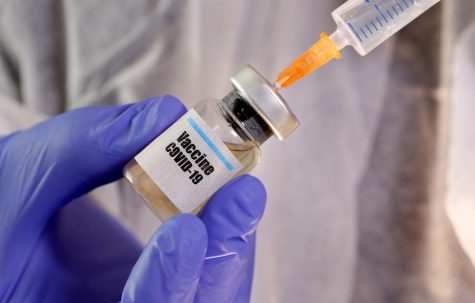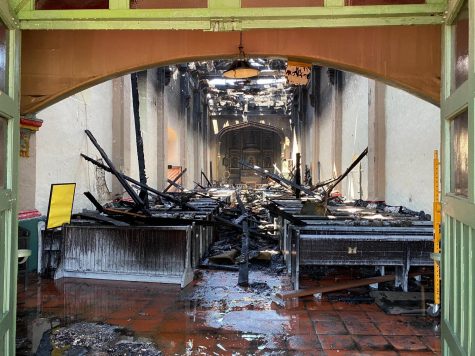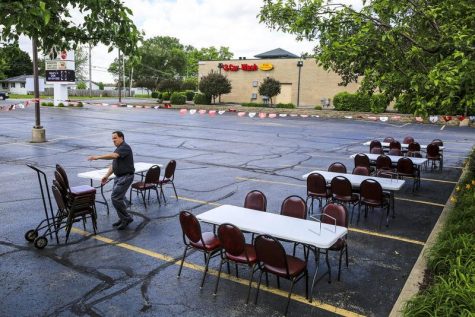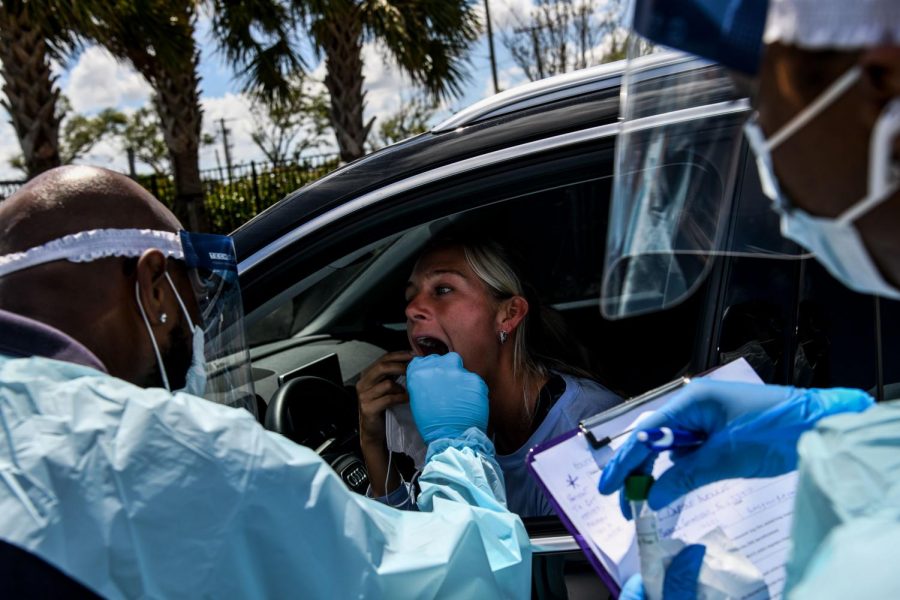Why Summer 2020 Will Be More Memorable Than We Thought
A researcher gives a COVID-19 test for someone who has possibly been waiting in line for a significant amount of time.
Summer 2020 was filled with uncertainty and fear as the United States struggled to conduct business as usual in an unusual year. We begin with the topic that is affecting the entire world:
- The Race for a COVID-19 Vaccine
Dr. Anthony Fauci, director of the National Institute of Allergy and Infectious Diseases and an expert on pandemics for the last 40 years, has been hopeful for a coronavirus vaccine to be developed by early 2021 but has previously said it is unlikely that a vaccine will deliver 100% immunity; he said the best realistic outcome, based on other vaccines, would be 75% effective.
60,000 volunteers of all backgrounds- people over age 65 or with chronic illnesses, and people of different ethnicities, including Hispanic and African-American, are participating in the phase III trials for the two leading drug companies- Moderna and Pfizer. Half of the study participants will receive the vaccine, and the other half will get a placebo. Who gets which version will be unknown to both the researchers and the participants.

“We feel absolutely on track, if not a little bit ahead,” of the goal of developing a safe, effective vaccine and producing tens of millions of doses by the end of the year, Paul Mango, deputy chief of staff for policy at the U.S. Department of Health and Human Services, said during a call with reporters.
At the Republican National Convention, President Donald Trump promised quick work on a vaccine by the end of 2020, saying the nation “will produce a vaccine before the end of the year, maybe even sooner.”
Some vaccines will be better recommended for certain groups, such as older people or people with compromised immune systems, said Dr. Gregory Poland, an infectious diseases expert who directs the Mayo Clinic’s Vaccine Research Group in Rochester, Minnesota.
“Young children are different than adults and different from elderly adults,” Poland said, adding that groups such as pregnant women and people who are immunocompromised may also react differently.
A coronavirus vaccine is key because the virus spreads quickly through respiratory droplets, and the majority of the world’s population is still susceptible to getting infected. A vaccine would provide some protection by training people’s immune systems to fight the virus so that they will not get sick, but a sufficient number of people have to get the vaccine to protect the immunocompromised, or else the vaccine would be ineffective.
2. Mayfield Finds Alternative Ways to Celebrate the Class of 2020
In a year of unexpected change, Mayfield made the difficult decision to forgo their traditional graduation festivities and substituted alternative ways to celebrate the class of 2020. School leadership worked hard to ensure the days leading up to graduation were as memorable as possible with creative ways to commemorate the class of 2020 and their achievements. Despite being apart, students enjoyed new versions of beloved senior traditions and looked forward to their fall plans and other future endeavours.

Instead of holding the mother-daughter Senior Tea in Strub Hall, Mayfield faculty and staff delivered a tea-for-two care package to each student’s home, so moms and their daughters could enjoy a special moment together. The annual car-decorating day, which is traditionally filled with laughter on the senior parking lot, was replaced with a jubilant car parade through campus, with mask-wearing faculty standing at six-foot intervals and holding signs of encouragement. Mayfield also celebrated the beloved class of 2020 with care packages including a Mayfield felt pennant and personalized yard signs; a teacher tribute webpage, where each senior received a special note from a faculty member and their “little sister,” and a digital message board filled with messages from Mayfield alumnae, faculty and staff, and family members.
Finally, it was time for the seniors to say goodbye to 500 Bellefontaine. When it was clear that the usual commencement exercises, with the students proudly receiving their diplomas and performing the rose petal toss simultaneously as their families watched on, could not be held, Mayfield had mini ceremonies for each of the 77 seniors over the span of five days. The girls wore their white gowns and gloves, were given their Holy Child medallions, and did their own solo versions of the rose petal toss! While enjoying the excitement of the new festivities, everyone was recognizing the history being made around this graduating class. Students and their families arrived on campus wearing face masks as COVID-19 cases continued to increase in Southern California. Some families had to reschedule their celebrations as Los Angeles County imposed curfews following social justice protests. The class of 2020 was not discouraged by the unexpected curveballs–they rode the waves with grace.
“Each member of this class has a passion and drive because of Mayfield,” Senior Class President Paloma Torres ‘20 said in her commencement speech.
“We were taught ‘Actions Not Words,’ thus we are a class that is globally minded, aware of the responsibility to use the voice and the privilege that we have been blessed with. And with that, we create a better world,” said Torres.
Head of School, Kate Morin, was proud of the students for facing every challenge they met this year with serenity and knew they would leave a meaningful mark on Mayfield when she first met them as freshman: “In my many long years as an educator, spending most of my waking hours thinking about and delighting in teenagers, I have never been as touched and inspired more than I have been by this group of girls,” said Morin.
3) San Gabriel Mission Burns Down
On July 11, officials received a call at 4:24 a.m. reporting that the San Gabriel Mission’s fire alarm had been set off. Upon arrival, firefighters saw flames and smoke coming from the corner of the mission. More fire trucks arrived on the scene, and firefighters were fighting the flames from inside the church building. Fifteen minutes in, portions of the structure began to fall on them, and the firefighters made the decision to exit and fight the flames from outside. At 6:48 a.m., the flames were extinguished.

When Mayfield Freshman English teacher, Julie Brehove, arrived at the scene at 9:30 a.m., she and her husband stood behind the barrier set up by firefighters and watched their spiritual home smolder.
As a result of the fire, the roof of the mission is completely gone, and the interior up to the altar is destroyed. The 107-year-old pews, which had been refurbished two weeks before, received major damage as well. Despite the blaze, there was still much to be grateful for, for the altar is still intact, and the historical wooden statues attached to it survived. According to Bishop David O’Connell, some of the mission’s statues and artwork had been removed and thus spared from the blaze.
“For all of us parishioners, it’s our gathering place, it’s the center of our spiritual lives,” Julie Brehove told LA Times adding she was grateful that no one was hurt in the fire.
4) Practicing Faith During Uncertain Times
On May 26, churches across LA County received a COVID-19 advisement from the Archdiocese of Los Angeles, and priests began working closely with parish leadership to devise plans for a safe reopening of their beloved spiritual communities. Churches such as St. Rita Parish in Sierra Madre recognized the need for volunteers willing to be trained and serve as monitors to ensure everyone was practicing health and safety protocols. Health screenings were conducted at the door, reservations for the day’s Mass were strongly encouraged, hand sanitizer was applied upon entrance and prior to receiving Holy Communion, and everyone had to maintain a six-foot distance from others. Priests and parish leadership were beyond grateful for the volunteers helping to reunite the spiritual community together again.
On July 13, California Governor Gavin Newsom announced a list of sectors required to close as the number of coronavirus cases continued to increase. Among the list were fitness centers, places of worship, offices for non-critical sectors, hair salons, and indoor malls. Although church communities were devastated to close their doors again, priests were grateful for the volunteers and congregation showing their dedication to safety, ministry, and community. Many parishes, including St Rita Parish, St. Philip the Apostle, and Assumption continue to livestream their Masses on social media platforms, while others, such as St. Therese in Alhambra, continue to hold their Church services but adhere to COVID-19 regulations, holding Mass outside and having the public wear masks, stay six feet apart from others, and wipe down their seats after use. Spiritual families across the country are looking forward to the pandemic subsiding and being reunited with their parish families and loved ones.
5) Tournament of Roses Announces Cancellation of 2021 Rose Parade
On July 15, the Tournament of Roses made the difficult decision to cancel a beloved New Year’s Day tradition that has been celebrated since 1890. On Instagram, they posted a picture of the Rose Parade logo under the following caption: “With reluctance and tremendous disappointment, we announce that… we are unable to host the 2021 #RoseParade… We may not be able to host our traditional five-mile march down Colorado Boulevard, but we are exploring new and safe ways we can collectively share in the celebration, and we look forward to announcing further details about our exciting new plans in the coming weeks.” People are anticipating what these “exciting new plans” will come out to be and are looking forward to what New Year’s Day 2021 will bring.
6) Coronavirus Testing Rate Drops Despite Increasing Death Toll
The coronavirus testing rate in the United States has dropped as cases increase and the death toll rises by more than 1,000 a day. Officials believe this has stemmed from Americans not wanting to wait in a long line for hours to get a test and days or weeks to receive the results. Another reason for the decline in testing is because doctors did not perform important tasks in commercial labs, resulting in prioritizing their highest-risk patients. An Associated Press analysis found that the number of tests per day dropped by 3.6% over two weeks to 750,000, with the count falling in states including Alabama, Mississippi, Missouri, and Iowa. Health experts are working to come up with a different type of test that would give results within minutes and would be simple enough for Americans to test themselves, but they worry the new test will not be as accurate.
7) Is It Safe to Go to the Beach?
A number of teenagers across the country still hit the waves this past summer, despite increasing COVID-19 numbers, and made a beeline for the most populated areas of sand. Some beachgoers visited within close proximity of each other, while others carefully searched for more open areas with fewer people. The question of whether it is safe to go to the beach in the midst of rising coronavirus cases has been up for debate for a while, but no exact answer has been given. In an interview with Heath Essentials, Dr. Joseph Khabbaza, pulmonary and critical care physician, discussed that while there are safety precautions and risks you should consider when going to the beach, he stated that it is extremely unlikely for the coronavirus to be transmitted by water.
“The virus probably doesn’t live very well in just water so it’s not going to live well in chlorinated water,” Dr. Khabbaza said. “And that goes, too, for larger natural bodies of water and saltwater, like at beaches. None of the respiratory issues have been described to be transmitted in a waterborne freedom.”
The real danger that occurs when you head for the shore is what health experts would call their worst nightmare: a large crowd of people calling dibs on their usual spots, not spacing their blankets six feet apart, children building their sandcastles too close to someone else’s, and all visitors sunbathing right next to each other. Unfortunately, it may mean skipping a visit if the area’s too crowded for social distancing. During the last few days before autumn begins, feel free to go to the beach when you have spare time- it would be a nice break from staring at your computer screen all week. Be sure to bring your mask, even though you will not be wearing it all the time.
“Even if you’re with your family but it feels a bit crowded or the distancing doesn’t feel right. If you’re too close to other people, a mask should be worn,” Dr. Khabazza added.
8) Outdoor Seating in Restaurants: From a Temporary Solution to a Possible Permanent Fixture
Some cities like Pasadena are trying to give businesses a boost with outdoor and on-street dining. In order for the restaurants to open their doors again in LA County, they must fulfill the requirement of outdoor seating, which calls for more distance between tables. City officials closed off parts of Old Town Pasadena so that restaurants could transform the busy streets into an outdoor dining experience with tables and chairs. Orange County soon followed in Pasadena’s lead and began making outdoor seating available. Restaurants laid out green carpets and turned parking lots into umbrellaed patios, hoping customers would feel safe and comfortable enough to sit down and enjoy a meal.

“I love the atmosphere,” says Andre Ayoub, one of the many outdoor diners in LA County. “It’s the outdoor atmosphere; I feel it’s very safe, all the tables are spread out, and you don’t feel like it’s a parking lot.”
Although outdoor dining is a great way to get people out of their homes and to help restaurants get back on their feet after experiencing financial hardships since March, it does not offer as many parking spaces for the customers. Cars will also start to crowd the roadways because of decreasing speed limits and not as many lanes are available for use. Town officials are working together to figure out what it will take to keep the outdoor dining area post-pandemic and are looking forward to dining, parking, zoning, and traffic impacts. Meanwhile, most customers think outdoor seating is a wonderful idea and say they hope to dine at their favorite restaurants more often, while other families feel it is best to stick to drive-thrus and take-out options and continue sheltering at home. Outdoor seating has made a huge difference after a harsh few months and is something restaurants hope not to lose.

Sophia Kroe is a senior at Mayfield Senior School and a staff writer for the Mayfield Crier. She joined the team of reporters her freshman year. Sophia...


